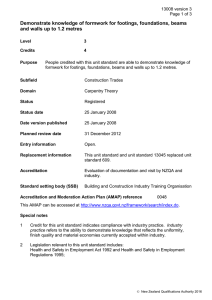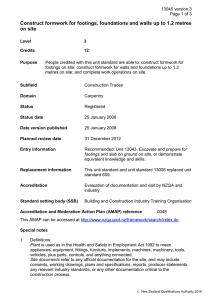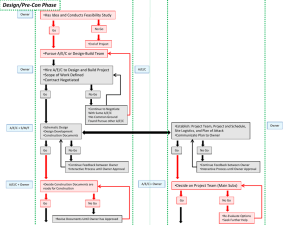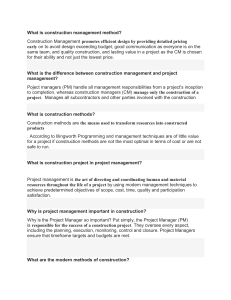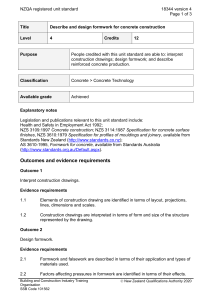Optimization of Vertical Formwork Layout Plans Using Mixed Integer Linear Programming - IM NOT THE OWNER
advertisement
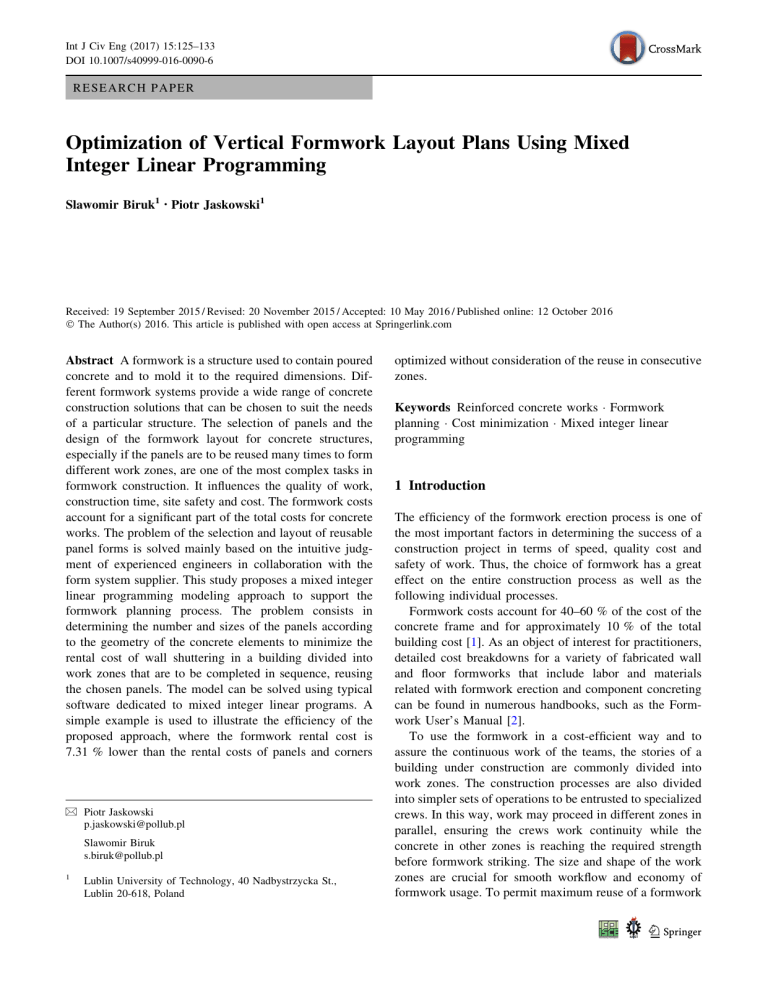
Int J Civ Eng (2017) 15:125–133 DOI 10.1007/s40999-016-0090-6 RESEARCH PAPER Optimization of Vertical Formwork Layout Plans Using Mixed Integer Linear Programming Slawomir Biruk1 • Piotr Jaskowski1 Received: 19 September 2015 / Revised: 20 November 2015 / Accepted: 10 May 2016 / Published online: 12 October 2016 The Author(s) 2016. This article is published with open access at Springerlink.com Abstract A formwork is a structure used to contain poured concrete and to mold it to the required dimensions. Different formwork systems provide a wide range of concrete construction solutions that can be chosen to suit the needs of a particular structure. The selection of panels and the design of the formwork layout for concrete structures, especially if the panels are to be reused many times to form different work zones, are one of the most complex tasks in formwork construction. It influences the quality of work, construction time, site safety and cost. The formwork costs account for a significant part of the total costs for concrete works. The problem of the selection and layout of reusable panel forms is solved mainly based on the intuitive judgment of experienced engineers in collaboration with the form system supplier. This study proposes a mixed integer linear programming modeling approach to support the formwork planning process. The problem consists in determining the number and sizes of the panels according to the geometry of the concrete elements to minimize the rental cost of wall shuttering in a building divided into work zones that are to be completed in sequence, reusing the chosen panels. The model can be solved using typical software dedicated to mixed integer linear programs. A simple example is used to illustrate the efficiency of the proposed approach, where the formwork rental cost is 7.31 % lower than the rental costs of panels and corners & Piotr Jaskowski p.jaskowski@pollub.pl Slawomir Biruk s.biruk@pollub.pl 1 Lublin University of Technology, 40 Nadbystrzycka St., Lublin 20-618, Poland optimized without consideration of the reuse in consecutive zones. Keywords Reinforced concrete works Formwork planning Cost minimization Mixed integer linear programming 1 Introduction The efficiency of the formwork erection process is one of the most important factors in determining the success of a construction project in terms of speed, quality cost and safety of work. Thus, the choice of formwork has a great effect on the entire construction process as well as the following individual processes. Formwork costs account for 40–60 % of the cost of the concrete frame and for approximately 10 % of the total building cost [1]. As an object of interest for practitioners, detailed cost breakdowns for a variety of fabricated wall and floor formworks that include labor and materials related with formwork erection and component concreting can be found in numerous handbooks, such as the Formwork User’s Manual [2]. To use the formwork in a cost-efficient way and to assure the continuous work of the teams, the stories of a building under construction are commonly divided into work zones. The construction processes are also divided into simpler sets of operations to be entrusted to specialized crews. In this way, work may proceed in different zones in parallel, ensuring the crews work continuity while the concrete in other zones is reaching the required strength before formwork striking. The size and shape of the work zones are crucial for smooth workflow and economy of formwork usage. To permit maximum reuse of a formwork 123 126 Int J Civ Eng (2017) 15:125–133 set in consecutive work zones, the zones should be of similar size, shape and work amount [3]. However, the configuration of walls in particular zones usually varies, and determining the composition of a ‘‘universal’’ set that can be used for all of them and, at the same time, remains cost-effective is not a simple task. If too many formwork elements are ordered, some will lay idle in storage areas. If too few elements are ordered, then the rotation of these elements increases and the possibility of damage grows; the quality and speed of the works might also suffer. Therefore, the formwork process should be well planned before construction begins [3], with the selection of a system allowing for the site-specific conditions and available equipment (e.g., the size and weight of the formwork elements need to be selected to meet the crane parameters, or vice versa) [1, 4]. The formwork plan should be preceded by an economic analysis (system selection) and contain assumptions on the organization of works, including division into work zones and the sequence of their processing. Even experienced practitioners find it very difficult to select an appropriate formwork system. The economic efficiency, repeatability of work and the shape of the structure represent the main selection criteria [5]. Proverbs et al. [6], based on a literature review and interviews with practitioners from the UK, France and Germany, identified nine predominant formwork selection factors. The authors ranked them in terms of importance for each international group of contractors and found that relative costs, specification (quality) of concrete and degree of repetition were the principal formwork selection criteria. Elazouni et al. [7] divided the factors for selecting the formwork system based on quantitative (cost and construction time) and qualitative (expected familiarity, flexibility, quality and safety) factors. The philosophy of decision making in every field of economics relates to assessing and selecting the most preferable solution, implementing it and then gaining the greatest profit [8]. Maximization of profit, in the case of formwork design, can be achieved by the reduction of rental or erection costs (or formwork labor) [9–11]. A number of effective decision-making methods that allow for multiple criteria have appeared in the last decade [12–16]. 2 Formwork Selection Problem The problem of selecting optimal formwork systems has been extensively studied in the literature [17–20]. A number of studies have proposed the application of neural network theory or expert systems [19, 21–23]. To assist the contractor with the formwork selection problem, Shin et al. 123 [24] presented a decision-support model using AdaBoost to select a formwork system suitable for the construction site conditions. In their later works, Shin et al. [25] proposed a formwork method selection model based on boosted decision trees intended for tall building problems. Shawki et al. [26] presented a model for determining the minimum weight for a heavy and high reinforced concrete slab formwork system taking account of the design, bearing and stability constraints. The genetic algorithm was built using MatLAB to solve the formwork problems. While the formwork layout is as important as formwork selection in improving productivity, there have been few studies on formwork layout [27]. Selection of the formwork element types and quantity according to the shape of the structure to be built is often offered as a service by formwork providers, who use dedicated computer systems, such as ELPOS by PERI GmbH or Tipos 7.0 by Doka GmbH. However, the criteria and methods of element selection used by these systems are not disclosed to their clients; they are most probably related with their business objectives and logistical constraints (availability at local logistic centers). For many contractors, formwork layout planning involves manual work and is done ad hoc according to the experience of the foremen and other site workers; this is a potential source of many errors [27]. These reasons determine the basis for the current interest in formwork optimization problems. Lee et al. [27], having analyzed the literature on the subject and interviewed formwork experts, listed the most important factors affecting formwork layouts, and proposed an algorithm for automated formwork layout planning that allowed for these factors. The authors stated that that the major factors in layout planning were: cost, constructability, safety, quality, and characteristics of the building and the site. They also described the sub-factors that determine the formwork layout. Lee et al. [27] used BIM (Building Information Modeling) to provide more precise information about the shape, dimensions, and the structure of the buildings than can be found on the existing 2D-based drawings. The system can improve productivity (reduction of workload and work time) and economic efficiency (reduction of formwork types and rational form dimension selection). Once the size of the forms is selected and the forms laid out, it can be decided whether or not a weight should be given to the number of reuses in view of the cost and the size of the forms in terms of constructability. Nevertheless, the exact procedure used for formwork optimization was not presented. Kannan and Santhi [28] proposed using the BIM technique to rationalize the formwork layout, incorporating the actual site characteristics and imparting the parametric Int J Civ Eng (2017) 15:125–133 change during construction. Their paper also provides the background concepts and techniques required to adopt the BIM as a simplified and intriguing tool to carry out the 4D Schedule and 5D Cost of the concrete formwork systems. The application of the BIM model to evaluate more formwork alternatives and consider design changes to increase efficiency and productivity was also presented by Meadati et al. [29]. An optimal formwork system to minimize project specific operation costs can be obtained by the use of a formwork selection model based on a modified CYCLONE method [30]. The formwork pairing problem in terms of scheduling wall erection operations and formwork allocation was studied by Benoist [31]. The author aimed to create formwork chains that could be moved from one wall to another without disassembling them in order to save labor costs and crane moves. The main criterion of formwork element allocation may also be minimizing the formwork stock [32]. Biruk and Jaskowski [9] presented a wall formwork layout optimization model for only one work zone. Biruk [33] developed the model for formwork set optimization without considering the possibility of changing the corner forming options. 127 corner. By taking into account the number of walls connected, three types of corners were distinguished: L-type (connecting two walls), T-type (three walls) and X-type (four walls). It was assumed that all walls meet at right angles. The decision on which option to select for a particular corner r was modeled by means of the following binary variables: yrwk 2 f0; 1gð8r 2 Ak ; 8w 2 WA ; 8k ¼ 1; 2; . . .; mÞ; zrwk 2 f0; 1g ð8r 2 Bk ; 8w 2 WB ; 8k ¼ 1; 2; . . .; mÞ; vrwk 2 f0; 1gð8r 2 Ck ; 8w 2 WC ; 8k ¼ 1; 2; . . .; mÞ: These variables assume the value of 1 if the option of w is selected to form corner r in work zone k, and the value of 0 in other cases. Only one option can be selected for each corner and only one variable for chosen variant can take the value 1, so the sum of these variables for all variants must be equal to 1. Therefore, the variables have to fulfill the following conditions: X yrwk ¼ 1; 8r 2 AK ; 8k ¼ 1; 2; . . .; m; ð1Þ w2WA X X 3 Problem Definition and Mathematical Formulation The formwork systems available on the market allow the user to obtain the same technically correct effect by means of a number of formwork element configurations, using several available types of corner and adjustment elements as well as sizes and configurations of the main wall panels. This makes formwork layout planning easier. If cost-efficient solutions are required, many possibilities of set composition should be evaluated, although this is a timeconsuming process without any guarantee of finding the optimal solution. Therefore, it is advisable to describe formwork optimization as a mathematical programming problem, and to solve it using commonly used software (e.g., LINGO, AIMMS, CPLEX, MATLAB and Optimization Toolbox, etc.), or to develop a solving procedure and implement it using dedicated decision-support software. The aim of the formwork layout planning is to assign the required panels to form the walls of each work zone and corner elements to form the junctions. The following assumptions were made to model the decision problem and the succeeding constraints were identified that limit the set of feasible solutions. Numerous formwork systems enable the user to select the optional corner formwork elements and accessories. There are specified solutions designed to form each type of zrwk ¼ 1; 8r 2 BK ; 8k ¼ 1; 2; . . .; m; ð2Þ vrwk ¼ 1; 8r 2 CK ; 8k ¼ 1; 2; . . .; m: ð3Þ w2WB w2WC The number of corner sets (corner elements and accessories) of a particular type and in each option can be determined as follows: X yw yrwk ; 8w 2 WA ; 8k ¼ 1; 2; . . .; m; ð4Þ r2Ak zw X zrwk ; 8w 2 WB ; 8k ¼ 1; 2; . . .; m; ð5Þ vrwk ; 8w 2 WC ; 8k ¼ 1; 2; . . .; m: ð6Þ r2Bk vw X r2Ck These sets will be reused to form corners on consecutive work zones—so their number should be calculated as the maximum number of sets used in each work zone. The inequalities (4)–(6), written in a linear form, allow the determination of a sufficient number of corner sets, minimized in the objective function of the linear program. The width of the adjustment elements compensating for the difference in the width of a wall limited by corners on both sides, in relation to the total width of the formwork elements, can be found on the basis of the following equation: n X lwjk ¼ djk si xijk ; 8j 2 Sk ; 8k ¼ 1; 2; . . .; m: i¼1 ð7Þ 123 128 Int J Civ Eng (2017) 15:125–133 It was assumed that this adjustment element should not be wider than 0.25 m, considering the widths of formwork elements in small-frame panel systems: 0:00 lwjk 0:25; 8j 2 Sk ; 8k ¼ 1; 2; . . .; m: ð8Þ Usage of more extensive adjustment elements is technically unjustified as they may be replaced by panels from the formwork system. This ensures the reduction of the labor input and guarantees better quality/evenness of the concrete surface.Fixed costs of utilizing an adjustment element are to be considered only when the adjustment element width is greater than 0. The variables of ujk 2 f0; 1g may assume the value of 1 (minimized in the objective function) only in the case that lwjk [ 0. Therefore lwjk M ujk ; 8j 2 Sk ; 8k ¼ 1; 2; . . .; m; The number of panels (and adjustment elements) is doubled because of the necessity to form both sides of the walls. Only corner elements are used individually. Finally, the objective function that minimizes total cost of hiring the formwork takes the following form: min z : z n m XX X xi ci þ 2 cs ujk ¼ j2Sk k¼1 i¼1 þ2 m XX lwjk cw þ j2Sk k¼1 þ X X w2WA ew yw þ X f w zw w2WB gw vw : w2WC ð9Þ ð13Þ where M is a sufficiently large number. In these cases, constraint (9) is fulfilled for any positive value of lwjk. If any adjustment element is redundant, the respective variables lwjk and ujk take the value 0. It was assumed that the total width of the elements for a wall that is not limited by corners on either side, or by the walls of work zones cast earlier, should be greater than the length of wall to be formed, but not exceeding the specified values: n X 0:05 si xijk djk 0:30; 8j 2 Sk nSk ; ð10Þ i¼1 The total cost of formwork hire involves the rental cost for a sufficient number of panels and corner sets, including the fixed and unit costs of preparing adjustment elements to form the walls in all work zones. The above model, including the objective function (13) and constraints (1)–(12), also requires boundary conditions for the decision variables (see: Table 1). The model excludes the details on the method of calculating the adjusted wall length as these are system specific, which are presented in the example below, created on the basis of a formwork system available in Europe. 8k ¼ 1; 2; . . .; m: The limiting values are formwork system specific, and should enable one to stop-end the form. The values of 0.05 and 0.30 m were proposed in formula (10) for walls with a corner on one edge. Assuming that only one work zone is being formed at a time, meaning that the next work zone can be formed only after the previous zone’s formwork has been released, the total number of i-type formwork panels (i = 1, 2,…, n) used to form walls in zone k (k = 1, 2,…, m) cannot be greater than the number of these panels rented for the project, which should be calculated to minimize the rental cost. Thus, the following relationship among these variables must hold true: xik xi ; 8i ¼ 1; 2; . . .; n; 8k ¼ 1; 2; . . .; m: ð11Þ The number of i-type elements for work zone k can be calculated on the basis of the following equation: X xik ¼ 2 xijk þ dik ; 8i ¼ 1; 2; . . .; n; j2Sk ð12Þ 8k ¼ 1; 2; . . .; m; where dik is the number of additional i-type elements needed to form the corners in zone k. 123 4 Example Figure 1 presents the layout for two separate work zones, A and B, composing the floor of the example building. All walls were 30 cm thick. The formwork system used in the example had panels of the following widths s1 = 0.30 m, s2 = 0.40 m, s3 = 0.45 m, s4 = 0.50 m, s5 = 0.75 m, s6 = 0.90 m, and s7 = 0.90 m (basic flat panels). Costs of hiring particular panels for a construction period (1 month) were, respectively, 15.50, 17.00, 17.75, 18.50, 22.50, 24.50, and 25.50 €. Fixed cost of preparing adjustment elements was assumed to be 50.00 €—high enough to avoid time-consuming carpentry works. The available options for forming corners are presented in Fig. 2. The monthly hiring costs of T-type, L-type and X-type corner elements and options were 48.50/30.00 €, 24.25/15.00 € and 97.00/60.00 €, respectively. Lower rental costs were assumed for options using steel elements. All values were assumed according to the data obtained from a formwork system supplier. For this formwork system, the number of additional elements used in forming corners can be determined as follows: Int J Civ Eng (2017) 15:125–133 129 Table 1 Symbols and notations m Number of work zones Sk Set of walls in the work zone k (k ¼ 1; 2; . . .; m) Sk Set of walls in the work zone k (k ¼ 1; 2; . . .; m), limited by corners on both sides Ak Set of T-type corners in the work zone k (k ¼ 1; 2; . . .; m) Bk Set of L-type corners in the work zone k (k ¼ 1; 2; . . .; m) Ck Set of X-type corners in the work zone k (k ¼ 1; 2; . . .; m) WA Set of options for T-type corners available in the considered formwork system WB Set of options for L-type corners available in the considered formwork system WC Set of options for X-type corners available in the considered formwork system ljk Length of wall j (j 2 Sk ), in the work zone k (k ¼ 1; 2; . . .; m), measured in plan between the corners n Number of formwork panel types si Width of a wall formwork panel, i-type (i ¼ 1; 2; . . .; n) ci Cost of hiring an i-type wall formwork panel (i ¼ 1; 2; . . .; n), together with connections ties, struts etc. for the duration of works determined on the basis of the work schedule, (EUR) cs Fixed cost of providing an adjustment element, (EUR) cw Unit cost of making an adjustment element, (€/m) ew Cost of hiring accessories accompanying T-type corners (angles, adjustment elements, clams, without panels) for the option: w 2 WA , (EUR) fw Cost of hiring accessories accompanying L-type corners for the option:w 2 WB , (EUR) gw Cost of hiring accessories accompanying X-type corners for the option:w 2 WC , in monetary units (EUR) int Set of integer numbers M A sufficiently large number xijk Number of i-type panels (i ¼ 1; 2; . . .; n) to be used for the wall j (j 2 Sk ) in work zone k (k ¼ 1; 2; . . .; m), xijk 2 int xik Number of i-type panels (i ¼ 1; 2; . . .; n) to be used for the whole work zone k ðk ¼ 1; 2; . . .; m), xik 2 int xi Number of i-type panels (i ¼ 1; 2; . . .; n) in the whole set rented for the considered project, xi 2 int lwjk Width of an adjustment element in the formwork of wall j (j 2 Sk ) in work zone k ðk ¼ 1; 2; . . .; m) yrwk Binary variable that models the decision of selecting option w to form T-type corner r in work zone k zrwk Binary variable that models the decision of selecting option w to form L-type corner r in work zone k vrwk Binary variable that models the decision of selecting option w to form X-type corner r in work zone k yw Number of corner sets (each set comprises corner elements without panels and accessories for one corner) in the corner option: w 2 WA zw vw Number of corner sets in the corner option: w 2 WB Number of corner sets in the corner option: w 2 WC djk Length of wall j (j 2 Sk ), in work zone k (k ¼ 1; 2; . . .; m), measured in plan between corners reduced by the width of the corner elements ujk Binary variable (ujk 2 f0; 1g), defined for walls in work zone k (k ¼ 1; 2; . . .; m), limited by corners on both sides (j 2 Sk ); it models the need for using an adjustment element Number of additional i-type panels needed to form corners in zone k dik d1k ¼ d2k ¼ d3k ¼ 0; 8k ¼ 1; 2; . . .; m; X X d4k ¼ d7k ¼ zr1k þ zr2k ; 8k ¼ 1; 2; . . .; m; d5k ¼ X r2Bk ð14Þ ð15Þ r2Bk yr2k ; 8k ¼ 1; 2; . . .; m; ð16Þ yr1k ; 8k ¼ 1; 2; . . .; m: ð17Þ r2Ak d6k ¼ X r2Ak Table 2 lists the formulas needed to determine the adjusted length of walls djk for combinations of corners that end the wall segments. The mathematic model of the problem was solved by means of LINGO 14.0 Optimization Modeling Software, and Table 3 gives the results. The solution presents the composition of the formwork set of the least rental cost for the work in both work zones, with the panel set used first to form the walls in zone A and then reused in zone B. Also the optimal panel sets are presented for zone A and zone B treated separately, as sets with minimal rental costs. The optimal formwork layouts for zones A and B are shown in Fig. 1. It is worth considering that zone B walls can be formed more cheaply than the walls in zone A, despite the fact that 123 130 Int J Civ Eng (2017) 15:125–133 300 6000 900 900 900 300 900 900 750 900 900 900 900 900 500 500 900 900 25 4600 900 900 900 300 25 0x 25 0 900 900 4300 900 0 0 25 25 0x 900 900 300 900 900 900 900 0x 750 750 500 750 900 25 900 900 work zone B work zone A 900 900 6000 900 900 400 900 900 400 900 4650 500 900 900 400 750 300 900 900 900 5850 5400 300 4800 Fig. 1 Example floor plan showing zones (a, b) the total lengths of the walls in both zones are similar. However, it would not be economical to form walls in this way when the work zones are cast subsequently and the panels can be reused. It would be necessary to rent greater numbers of panels and elements of each type (maximum number from columns 4 and 5 for each row in Table 3) to form the walls in zone A and then zone B. The rental cost for this solution is 1408.25 €, so 103 € more than for a formwork set optimized for both zones. While optimizing the formwork plans, it is important to bear in mind the assumptions on formwork reuse in consecutive zones. The solution was obtained using a mixed linear program solver, for which the limits of variables and constraint numbers in the solved problem depend significantly on the purchased license type, as is the case with other programs. However, if the floor layout was more complex, and the number of constraints and variables greater as in the example, it would be advisable to develop metaheuristic, e.g., genetic or evolutionary algorithms, tabu search, simulated annealing, etc. that could provide solutions within a reasonable period of time. Despite its basic advantage of reducing the computational effort, this approach also has certain disadvantages. Metaheuristics facilitate only the determination of suboptimal solutions, which are relatively good rather than optimal. Effective methods are still being 123 developed to take the constraints into account during the generation of feasible solutions and their recombination using specific operators. The quality of the solution obtained by most metaheuristic methods depends on the algorithm parameters and options, such as coding scheme, population size, mutation probability, and type of crossover. Metaheuristics only determine the problem solving scheme, while the development of an algorithm to solve certain class problems requires IT skills. Developing efficient metaheuristics suitable for the analyzed problem is area for future research by the authors. 5 Conclusions The development of formwork systems parallels that of the growth in concrete construction throughout the past few decades. Different formwork systems allow a wide range of concrete construction solutions that can be chosen to suit the needs of a particular structure. The erection of cast-in-place concrete structures, though having a long tradition, remains a challenge for the builder, not only in terms of technical expertise regarding the material but also the ability to select suitable formwork solutions from those present in the market. As price is most Int J Civ Eng (2017) 15:125–133 900 900 300 300 300 300 100 300 500 300 300 (a) 131 300 300 750 300 300 300 50 250 300 250 300 250 300 250 900 50 500 (b) 300 300 300 250 300 300 250 250 300 250 250 Fig. 2 Panel arrangement for L-, T-, and X-type corners: a option 1: aluminum elements, b option 2: steel elements Table 2 Formulas for calculating adjusted length of walls djk Corner type s (front) and t (end) s t 2 Ak t 2 Bk t 2 Ck No corner s 2 Ak djk ¼ ljk 0:30ys1k djk ¼ ljk 0:30ys1k djk ¼ ljk 0:30ys1k djk ¼ ljk 0:30ys1k 0:25ys2k 0:30yt1k 0:25yt2k 0:25ys2k 0:25zt1k 0:30zt2k 0:25ys2k 0:30mt1k 0:25mt2k s 2 Bk djk ¼ ljk 0:25zs1k 0:30zs2k 0:30yt1k 0:25yt2k djk ¼ ljk 0:25zs1k 0:30zs2k 0:25zt1k 0:30zt2k djk ¼ ljk 0:25zs1k 0:30zs2k 0:30mt1k 0:25mt2k djk ¼ ljk 0:25zs1k 0:30zs2k s 2 Ck djk ¼ ljk 0:30ms1k 0:25ms2k 0:30yt1k 0:25yt2k djk ¼ ljk 0:30ms1k 0:25ms2k 0:25zt1k 0:30zt2k djk ¼ ljk 0:30ms1k 0:25ms2k 0:30mt1k 0:25mt2k djk ¼ ljk 0:30ms1k 0:25ms2k No corner djk ¼ ljk 0:30yt1k 0:25yt2k djk ¼ ljk 0:25zt1k 0:30zt2k djk ¼ ljk 0:30mt1k 0:25mt2k djk = ljk often the main criterion of a contractor’s bid assessment, contractors struggle to reduce costs and improve their chances of winning the contract. Taking into account the high share of formwork costs in the general execution costs of concrete works and cast-inplace structures, the issue of optimization of vertical formwork layout plans to reduce formwork rental cost, as analyzed in this paper, is of high practical significance. The market has a shortage of tools facilitating formwork 0:25ys2k selection optimization, while the majority of existing software supporting formwork layout plans are developed at the systems suppliers’ request, which in the contractors’ opinion do not provide optimum solutions minimizing their costs. The paper takes into account the possibility of reusing panels for consecutive work zones, which so far has been omitted by research and software developers. The results obtained in the example have confirmed that optimization 123 132 Int J Civ Eng (2017) 15:125–133 Table 3 Solution for the example Variable Symbol Solution with minimal rental cost for two work zones Solution with minimal rental cost for zone A Solution with minimal rental cost for zone B 1 2 3 4 5 Number of wall panels, 0.30 m wide x1 0 0 0 Number of wall panels, 0.40 m wide Number of wall panels, 0.45 m wide x2 x3 0 0 4 0 2 0 Number of wall panels, 0.50 m wide x4 5 3 4 Number of wall panels, 0.75 m wide x5 9 7 2 Number of wall panels, 0.90 m wide x6 36 36 40 Number of universal wall panels, 0.90 m wide 1 1 0 Total width of wooden adjustment elements x7 m PP 0 0 0 Number of 0.30 9 0.30 m aluminum corner elements y1/z1/v1 0/0/0 0/0/0 0/0/0 Number of 0.25 9 0.25 m steel corner elements y2/z2/v2 1/1/1 1/1/0 0/0/1 1305.25 1231.75 1192.50 lwjk j2Sk k¼1 Total rental cost of the set (EUR) of selection panels to form walls for all work zones demonstrates a high cost reduction potential. The relative amount of the savings obtained is close to the profit rate assumed in cost estimations. The suggested model, written using mathematical symbols, takes into account the specific requirements (criteria, limits) of the issue in question. It provides a specific scheme that may facilitate modeling of given practical problems by introducing/determining real parameter values. The model of the wall formwork set configuration problem proposed by the authors, being linear and of integer and binary variables, can be solved using widely available solvers. However, it is recommended that it is developed into an independent computer application—a formwork layout planning decision-support system. Acknowledgments This work was financially supported by Ministry of Science and Higher Education within the statutory research program, S/63/2015. Open Access This article is distributed under the terms of the Creative Commons Attribution 4.0 International License (http://crea tivecommons.org/licenses/by/4.0/), which permits unrestricted use, distribution, and reproduction in any medium, provided you give appropriate credit to the original author(s) and the source, provide a link to the Creative Commons license, and indicate if changes were made. References 1. Hanna AS (2005) Concrete formwork systems. Marcel Dekker Inc, New York 2. Harsco, Formwork User’s Manual. Tables, Work scheduling, Concrete Engineering, Site safety, Harsco Infrastructure (2010) 123 3. American Concrete Institute Committee 347 (2014) Guide to Formwork for Concrete (ACI 347R–14). American Concrete Institute, Farmington Hills, MI 4. Peurifoy RL, Schexnayder CJ, Shapira A (2006) Construction planning, equipment, and methods. McGraw-Hill International Edition, New York 5. Kapp MJ, Girmscheid G (2006) Empirical study reveals deficits in the choice of formwork. In: Pietroforte R, De Angelis E, Polverino F (eds) Construction in the XXI century: local and global challenges. Proceedings of the Joint 2006 CIB W065/ W055/W086 international symposium. Edizione Scientifiche Italiane, Napoli, pp 172–173 6. Proverbs DG, Holt GD, Olomolaiye PO (1999) Factors in formwork selection: a comparative investigation. Build Res Inf 27(2):109–119 7. Elazouni AM, Ali AE, Abdel-Razek RH (2005) Estimating the acceptability of new formwork systems using neural networks. J Const Eng Manag 131(1):33–41 8. Zavadskas EK, Turskis Z (2011) Multiple criteria decision making (MCDM) methods in economics: an overview. Technol Econ Dev Econ 17(2):397–427 9. Biruk S, Jaskowski P (2013) Economic criteria for the selection of wall formwork (in Polish). Civil Eng Archit 12(1):7–14 10. Jarkas AM (2010) The impacts of buildability factors on formwork labor productivity of columns. J Civil Eng Manag 16(4):471–483 11. Dikmen SU, Sonmez M (2011) An artificial neural networks model for the estimation of formwork labor. J Civil Eng Manag 17(3):340–347 12. Balezentis A, Balezentis T, Misiunas A (2012) An integrated assessment of Lithuanian economic sectors based on financial ratios and fuzzy MCDM methods. Technol Econ Dev Econ 18(1):34–53 13. Kaplinski O, Peldschus F (2011) The problems of quantitative evaluation of socio-economic systems development: review. Inz Ekon Eng Econ 22(4):345–355 14. Liou JJH (2013) New concepts and trends of MCDM for tomorrow—in honor of professor Gwo-Hshiung Tzeng on the occasion of his 70th birthday. Technol Econ Dev Econ 19(2):367–375 15. Podvezko V (2011) The comparative analysis of MCDA methods SAW and COPRAS. Inz Ekon Eng Econ 22(2):134–146 Int J Civ Eng (2017) 15:125–133 16. Stanujkic D, Magdalinovic N, Jovanovic R, Stojanovic S (2012) An objective multi-criteria approach to optimization using the Moora method and interval grey numbers. Technol Econ Dev Econ 18(2):331–363 17. Hanna AS, Sanvido VE (1990) Interactive vertical formwork selection system. Concr Int 12(4):26–32 18. Hanna AS, Sanvido VE (1991) Interactive horizontal formwork selection system. Concr Int 13(8):50–56 19. Kamarthi SV, Sanvido VE, Kumara SRT (1992) Neuroform— neural network system for vertical formwork selection. J Comput Civil Eng 6(2):178–199 20. Abd-Elrazek ME (1999) Formwork selection systems in building construction. J Eng Appl Sci 46(4):629–644 21. Elbeltagi E, Hosny OA, Elhakeem A, Abd-Elrazek ME, Abdullah A (2011) Selection of slab formwork system using fuzzy logic. Constr Manag Econ 29:659–670 22. Shin Y (2011) Formwork system selection model for tall building construction using the Adaboost algorithm. J Korea Inst Build Constr 11(5):523–529 23. Tam CM, Tong TKL, Lau TCT, Chan KK (2005) Selection of vertical formwork system by probabilistic neural networks models. Constr Manag Econ 23:245–254 24. Shin Y, Kim DW, Yang SW, Cho HH, Kang KI (2008) Decision support model using the AdaBoost algorithm to select formwork systems in high-rise building construction. In: Proceedings of the 25th international symposium on automation and robotics in construction, Vilnius. Gediminas Technical University Publishing House ‘‘Technika’’, Vilnius, Lithuania, pp 644–649 25. Shin Y, Kim T, Cho H, Kang K-I (2012) A formwork method selection model based on boosted decision trees in tall building construction. Autom Constr 23:47–54 133 26. Shawki KM, Emam MA, El-B Osman (2012) Design and construction of multitier shoring towers. J Eng Sci Assiut Univ 40(3):689–700 27. Lee C, Ham S, Lee G (2009) The development of automatic module for formwork layout using the BIM. In: Proceedings of the international conference on construction engineering and management/project management (ICCEM/ICCPM 2009), Jeju, Korea 1266–1271 28. Kannan MR, Santhi MH (2013) Automated construction layout and simulation of concrete formwork systems using building information modeling. In: Proceedings of the 4th international conference of Euro Asia civil engineering forum on innovations in civil engineering for society and the environment, National University of Singapore, Singapore, C7–C12 29. Meadati P, Irizarry J, Aknoukh A (2011) BIM and concrete formwork repository. In: Proceedings 47th ASC annual international conference, associated schools of construction, Omaha, US 30. Kersting M, Girmscheid G (2011) Process-oriented analysis of the interactions among formwork related teams with a modified Cyclone. In: Proceedings of the 6th international structural engineering and construction conference (ISEC-6) model modern methods and advances in structural engineering and construction, Zürich, Switzerland, 167–173 31. Benoist T (2007) Towards optimal formwork pairing on construction sites. RAIRO Oper Res 41(4):381–398 32. Benoist T, Jeanjean A, Molin P (2009) Minimum formwork stock problem on residential buildings construction sites. 4OR–A Q J Oper Res 7:275–288 33. Biruk S (2013) Minimizing wall formwork cost in residential building construction. Int J Arts Sci 6(3):355–362 123


